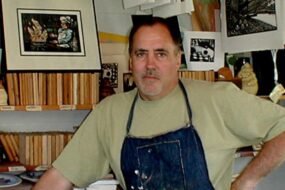
When Cina He, MCAS ’25 and LSEHD ’25, arrived at her grandparents’ home in Guilin, China, at the end of her junior year at Boston College, she witnessed the aftermath of a severe flood that altered the river-based city’s flora and fauna.
Aside from the effects of climate change in Guilin, located in He’s native province of Guangxi, she was struck by the subtle and overt socio-political transformations she encountered.
More Than A Village, He’s upcoming solo art exhibition, will celebrate its opening on Oct. 17 at 6 p.m. in Carney 203. The exhibition explores the environmental and cultural shifts that continue to develop in Guangxi.
The exhibition is the result of He’s time in Guilin as the apprentice of sixth-generation artist Hu Bo. During her time at Hu’s studio, He learned the traditionally passed-down skill of woodblock printing, a Chinese printing technique that involves carving a unique design on a piece of wood to create a representation of folk culture and religion.
From a young age, He has been interested in making art. It was only when she moved from Liuzhou to Buenos Aires at age 12 that she found the encouragement she needed to see the potential of art as a career rather than a hobby. In her time at BC, she was awarded the Arts Council Award at the 2024 Arts Fest, and in 2023 she received the Salmanowitz Film Grant, which made it possible for her to co-produce Hagamos que el Arte Suceda, a documentary filmed in Buenos Aires exploring the social impact of independent theater and performance art through interviews.
After receiving the Advanced Study Grant in the 2023–’24 school year, He was determined to come into her senior year at BC with a collection of art pieces to assemble her first solo exhibition. He wanted to craft an exhibition that would celebrate the cultural landscape that had influenced her as an artist and individual.
During her extensive time in Hu’s studio over Summer Break, He learned that an apprentice normally needs to spend a year in the print shop just to master the alchemic relationship between water and paint on wood. It is a necessary step before someone can begin carving on a woodblock or even developing their own print designs.
He challenged this typical time frame by condensing this process to seven arduous days.
Every morning, He would ride a moped from her grandparent’s house to Hu’s studio, where she spent around six hours under his guidance. She then spent her 30-minute ride home reflecting on the ways she would improve the following day.
In many ways, He believes that the process and post-process of woodblock printing mirror the changing systems that makeup Guangixi’s environment.

“Wood blocks—they morph and they deform if there is a change in humidity or temperature,” He said. “So the four wood blocks I have right now in the gallery, they probably would not print exactly like they did a month ago.”
It takes courage and a sincere passion for art to accept the ephemeral nature of one’s work. Historically, possessing and making art has been an attempt toward immortality.
Chinese emperors and powerful figures worldwide were buried with funerary art that was believed to follow the dead in their afterlife. The Ming Dynasty, for example, believed that the ceramic pieces that high-ranking members were buried with would last forever, an idea that the emergence of museums has since committed to with its careful preservation of art as a way to document history. But outside of museums, where temperature and humidity conditions cannot be controlled, life does not work like that, He says.
What makes woodblocking particularly interesting to He is precisely that it does not fight against entropy, but rather is a symbol of it.
“The art Hu Bo practices is the art of impermanence,” He said regarding her mentor.
Like nature, He’s art pieces featured in More Than A Village are also impermanent. Woodblock, like the environment, has characteristics that inevitably change in response to climate conditions—a fact that He embraces as an element that adds to this art form’s intangible value.
In More Than A Village, He’s original woodblock print design pictures the Hong Kong orchid, a flower that had its bloom interrupted by this year’s flood, and the Chinese merganser, an endangered bird that appears during winter. The images reflect on the vulnerable balance between nature and human activity, He says.
Art students in China, He explains, are trained to create art that sells, or art that is easy to market outside of China. What is lost within this process, then, are the artistic abilities that do not necessarily create a profitable product, but carry on cultural heritage and the generational practice of woodblock printing.
“If we only treat art as a product, then where is the cultural aspect?” He asked.
When stepping into her exhibition, viewers might want to ponder He’s question.












